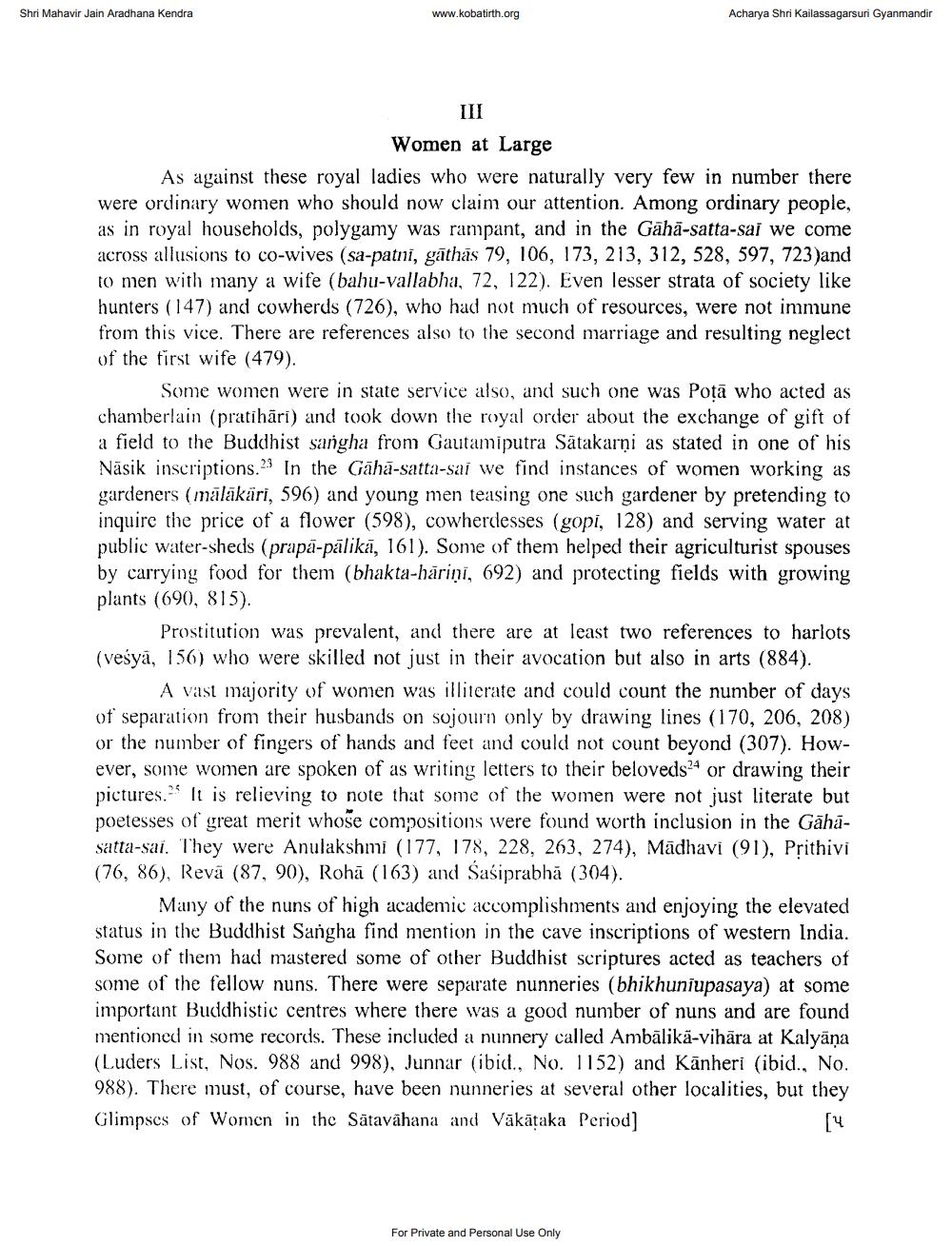Book Title: Samipya 2000 Vol 17 Ank 03 04 Author(s): Bhartiben Shelat, R T Savalia Publisher: Bholabhai Jeshingbhai Adhyayan Sanshodhan Vidyabhavan View full book textPage 8
________________ Shri Mahavir Jain Aradhana Kendra www.kobatirth.org III Women at Large Acharya Shri Kailassagarsuri Gyanmandir As against these royal ladies who were naturally very few in number there were ordinary women who should now claim our attention. Among ordinary people, as in royal households, polygamy was rampant, and in the Gähä-satta-sai we come across allusions to co-wives (sa-patni, gāthās 79, 106, 173, 213, 312, 528, 597, 723)and to men with many a wife (bahu-vallabha, 72, 122). Even lesser strata of society like hunters (147) and cowherds (726), who had not much of resources, were not immune from this vice. There are references also to the second marriage and resulting neglect of the first wife (479). Some women were in state service also, and such one was Pota who acted as chamberlain (pratthärt) and took down the royal order about the exchange of gift of a field to the Buddhist sangha from Gautamiputra Satakarni as stated in one of his Näsik inscriptions. In the Gähä-satta-sal we find instances of women working as gardeners (mäläkäri, 596) and young men teasing one such gardener by pretending to inquire the price of a flower (598), cowherdesses (gopi, 128) and serving water at public water-sheds (prapā-pālikā, 161). Some of them helped their agriculturist spouses by carrying food for them (bhakta-hāriņi, 692) and protecting fields with growing plants (690, 815). Prostitution was prevalent, and there are at least two references to harlots (vesya, 156) who were skilled not just in their avocation but also in arts (884). A vast majority of women was illiterate and could count the number of days of separation from their husbands on sojourn only by drawing lines (170, 206, 208) or the number of fingers of hands and feet and could not count beyond (307). However, some women are spoken of as writing letters to their beloveds24 or drawing their pictures. It is relieving to note that some of the women were not just literate but poetesses of great merit whose compositions were found worth inclusion in the Gähäsatta-sai. They were Anulakshmi (177, 178, 228, 263, 274), Madhavi (91), Prithivi (76, 86). Revä (87, 90), Rohā (163) and Sasiprabha (304). Many of the nuns of high academic accomplishments and enjoying the elevated status in the Buddhist Sangha find mention in the cave inscriptions of western India. Some of them had mastered some of other Buddhist scriptures acted as teachers of some of the fellow nuns. There were separate nunneries (bhikhuniupasaya) at some important Buddhistic centres where there was a good number of nuns and are found mentioned in some records. These included a nunnery called Ambälikä-vihāra at Kalyana (Luders List, Nos. 988 and 998), Junnar (ibid., No. 1152) and Kanheri (ibid., No. 988). There must, of course, have been nunneries at several other localities, but they Glimpses of Women in the Satavahana and Vākāṭaka Period] [પ For Private and Personal Use OnlyPage Navigation
1 ... 6 7 8 9 10 11 12 13 14 15 16 17 18 19 20 21 22 23 24 25 26 27 28 29 30 31 32 33 34 35 36 37 38 39 40 41 42 43 44 45 46 47 48 49 50 51 52 53 54 55 56 57 58 59 60 61 62 63 64 65 66 67 68 69 70 71 72 73 74 75 76 77 78 79 80 81 82 ... 84
